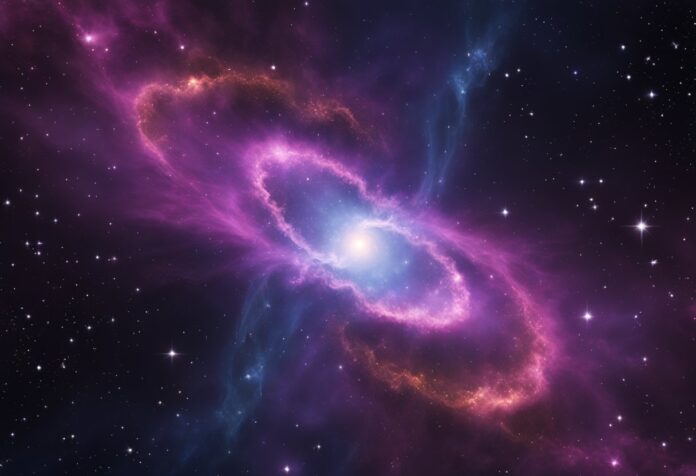
The origin of matter is really a perplexing subject. Where did it all come from? How did the universe come into existence?
These are the questions that still can’t be answered completely. However, with the advancement of technology and the development of new theories, we are getting closer to unraveling this mystery.
Some people believe that everything was created during the Big Bang. Others believe that God created everything.Then, of course, we also have the simulation theory.
Actually, there have been thousands of theories over a thousand years but none have been proven yet. And perhaps we’ll never know the true story.
Nonetheless, here at CuriousMatrix.com, we are very curious and this is certainly one of the most interesting questions out there.
So, let’s begin. Let’s explore different theories trying to explain the origin of matter and thus origin of the universe.
Interesting fact: Did you know that matter can exist in a state called Bose-Einstein Condensate (BEC)? In this state, which occurs at temperatures close to absolute zero, a group of atoms is cooled to near absolute zero. Under such extreme conditions, the atoms begin to occupy the same space and quantum state, essentially behaving as a single quantum entity with wave-like properties. This state of matter allows scientists to explore quantum phenomena on a macroscopic scale, making it a fascinating area of research in quantum physics.
The Big Bang Theory
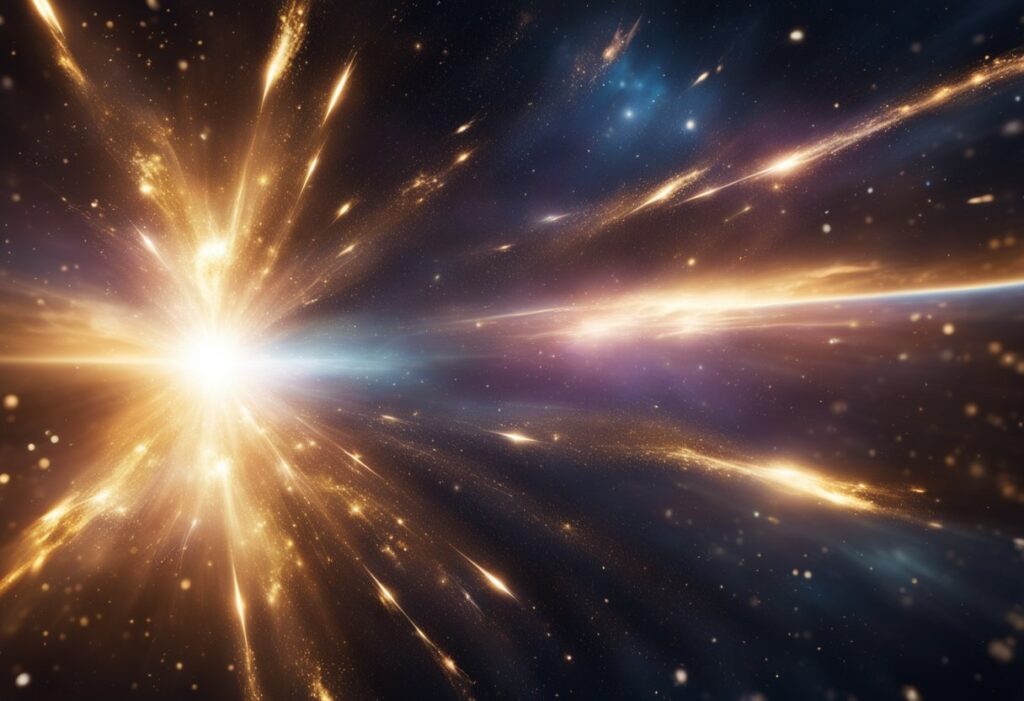
The Initial Singularity
According to the Big Bang Theory, the universe began as a singularity, a point of infinite density and temperature. The universe then rapidly expanded and cooled down, resulting in the formation of matter and the universe as we know it today.
We all know that this event is called the Big Bang.
Interesting fact: According to theory the initial singularity was incredibly small, about the size of a single atom.
Cosmic Inflation
After the initial expansion, the universe underwent a period of exponential expansion known as cosmic inflation. This period lasted for less than a second but had a significant impact on the universe’s structure.
During this time, quantum fluctuations were stretched to cosmic scales, resulting in the formation of galaxies and large-scale structures.
Interesting fact: Cosmic inflation is believed to have occurred at a speed faster than the speed of light.
Nucleosynthesis and Light Elements
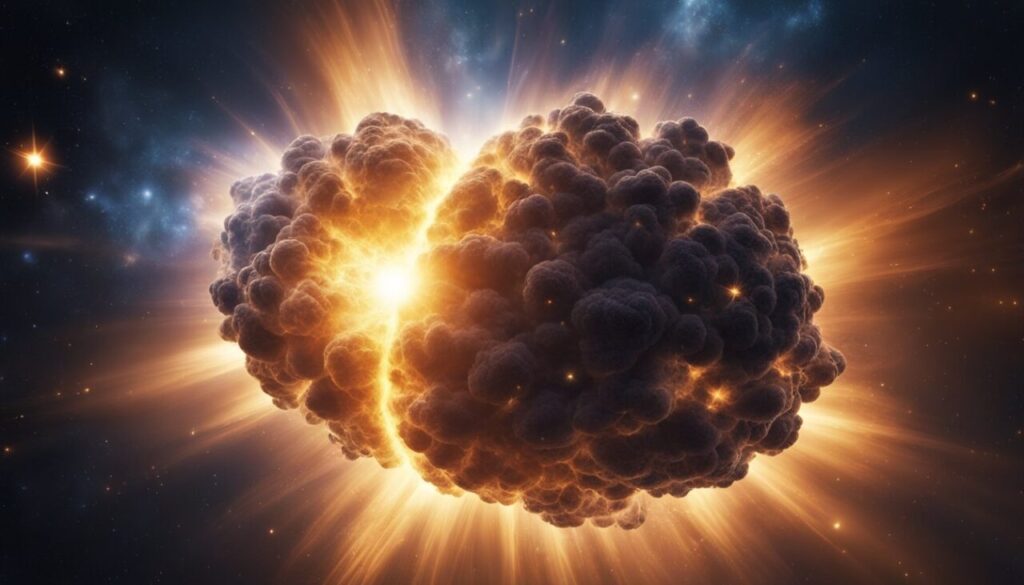
During the first few minutes after the Big Bang, the universe was hot and dense enough for nuclear reactions to occur.
Within the first few seconds, fundamental particles like quarks and electrons formed. These particles combined to create protons and neutrons, which then again combined to form the nuclei of simple elements like hydrogen and helium during a period called nucleosynthesis.
Overall, the Big Bang Theory provides a good enough explanation for the origin of the universe and the formation of matter.
However, there are still many unanswered questions in the Big Bang theory.
What happened before the Big Bang? Why Big Bang? No one knows and perhaps we’ll never know.
Remember – Big Bang is still a theory and while it is backed by solid evidence there are many scientists proposing different theories such as Steady State Theory, Ekpyrotic Theory, Conformal Cyclic Cosmology, and many others.
Interesting fact: Did you know that most of the helium in your party balloons was made in the first three minutes after the Big Bang? During this time, the universe was like a cosmic kitchen cooking up the lightest elements, and it's where nearly all the helium in the universe today comes from!
Matter-Antimatter Asymmetry
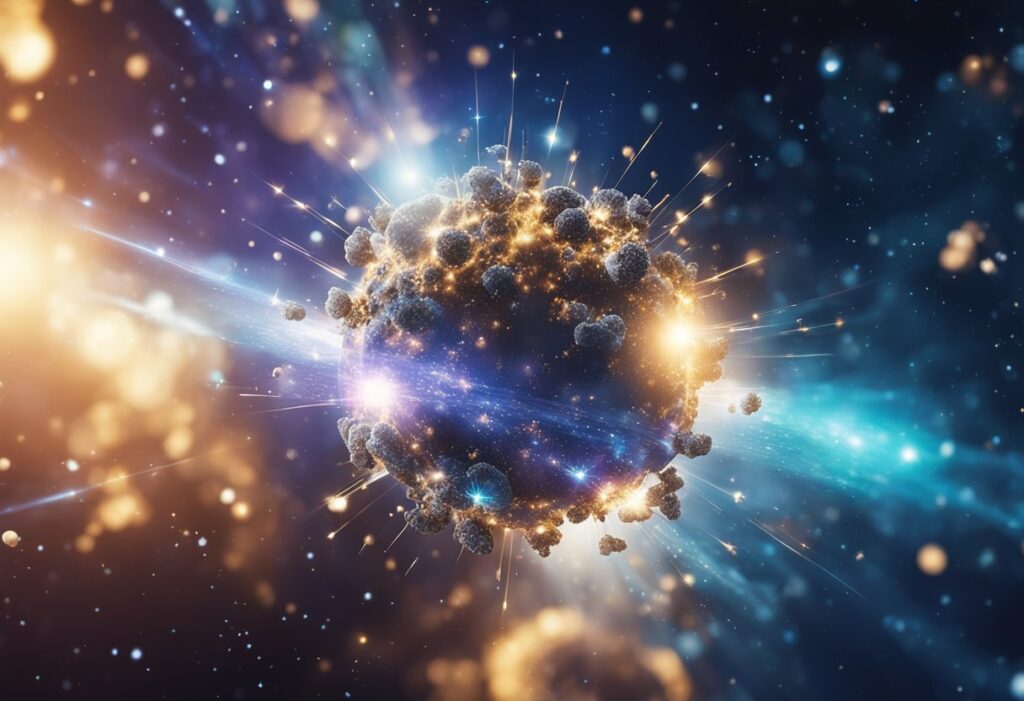
Baryogenesis
One of the biggest mysteries in modern physics is why there is more matter than antimatter in the universe. Many theories have been proposed to explain this phenomenon.
One of the most popular theories is called baryogenesis, which suggests that during the early universe, there was a process that created more matter than antimatter.
Baryogenesis is a process that occurs when the universe is in a state of high energy. During this time, particles and antiparticles are constantly being created and destroyed.
However, if there is a slight imbalance in the creation of particles and antiparticles, then there will be more particles than antiparticles left over at the end of the process.
Oh, yeah before continuing we first need to explain what antimatter is.
Antimatter is essentially the opposite of regular matter (hence the name 😊).
For every particle of normal matter, there is a corresponding antimatter particle with the same mass but an opposite electric charge.
For example:
- The antimatter counterpart of the electron is the positron, which has the same mass as an electron but a positive charge.
- The antiproton is the antimatter counterpart of the proton, having the same mass but a negative charge.
When matter and antimatter come into contact, they annihilate each other in a burst of energy, usually producing photons (light particles) in the process.
This annihilation releases a significant amount of energy, which is why antimatter is often mentioned in science fiction as a potential high-energy fuel source.
Interesting fact: Antimatter has been used in popular culture as a power source for futuristic spacecraft! In science fiction, antimatter engines are often portrayed as incredibly powerful and efficient propulsion systems that could potentially enable spacecraft to travel vast distances in short amounts of time. While this concept is still purely speculative and far from reality, it could become a possible solution for interstellar travel in the distant future.
Sakharov Conditions
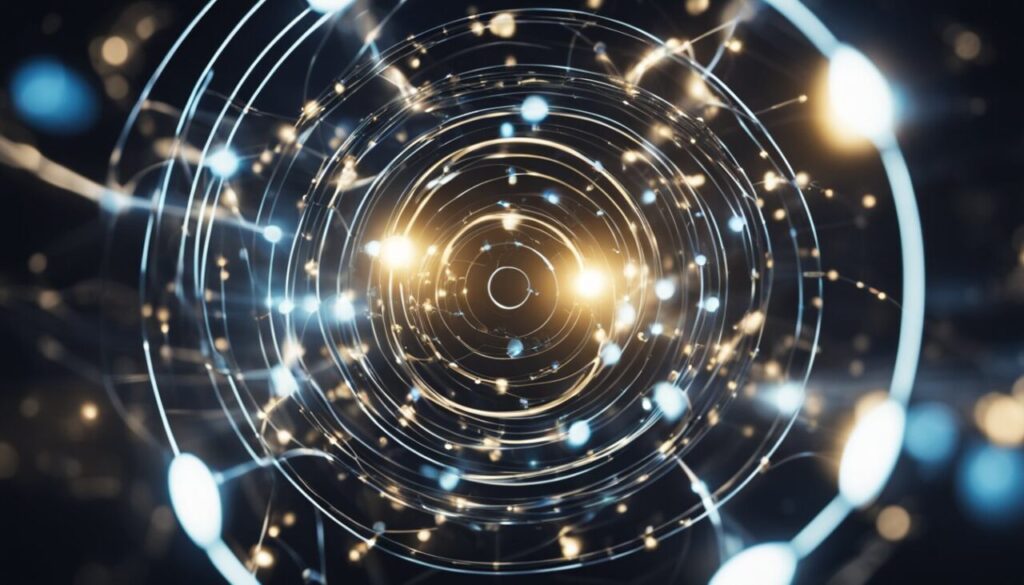
The Sakharov conditions are a set of three conditions that must be met in order for baryogenesis to occur. The first condition is that there must be a violation of baryon number conservation.
The second condition is that there must be a violation of C-symmetry, which is a symmetry that relates particles to their antiparticles.
The third condition is that there must be a violation of CP-symmetry, which is a symmetry that relates particles to their mirror images.
The Sakharov conditions are important because they help to explain why there is more matter than antimatter in the universe.
If these conditions were not met, then there would be an equal amount of matter and antimatter in the universe, which would make it impossible for life to exist.
Interesting fact: The Sakharov conditions were first proposed by Andrei Sakharov in 1967.
CP Violation
CP violation is a phenomenon that occurs when the laws of physics do not behave the same way for particles and their antiparticles. This violation is important because it is one of the conditions that must be met in order for baryogenesis to occur.
CP violation was first discovered in the 1960s, and it has been studied extensively ever since.
Scientists are still trying to understand why CP violation occurs and how it can be used to explain the matter-antimatter asymmetry in the universe.
Interesting fact: The study of CP violation has led to the discovery of several new particles, including the charm quark and the tau neutrino.
Energy to Matter Conversion
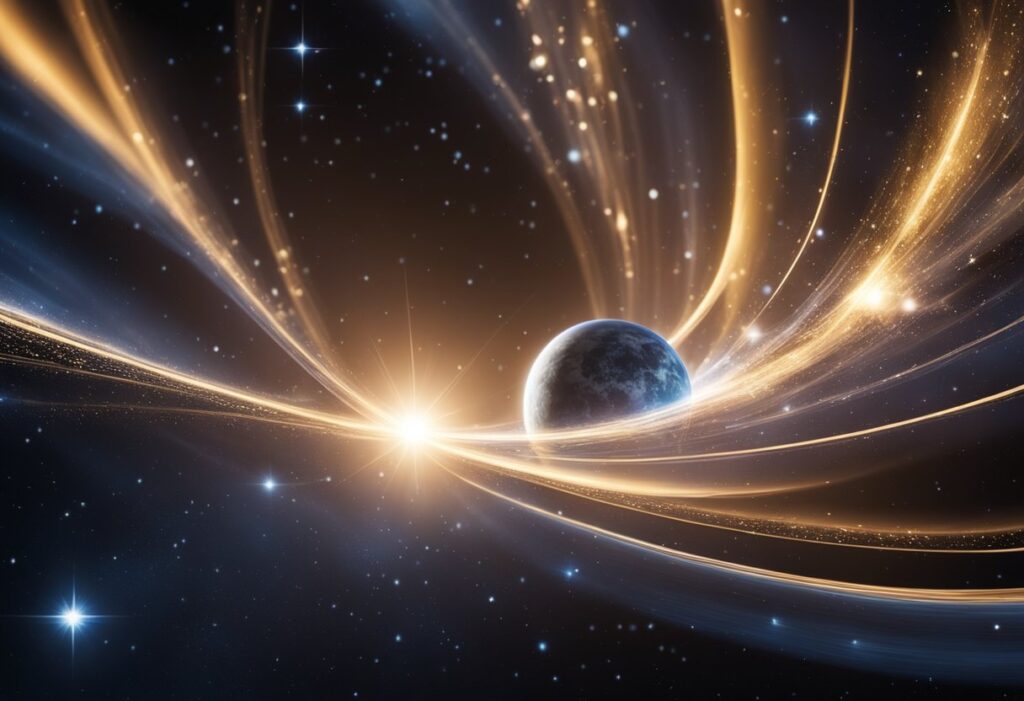
E=mc^2 and Particle Physics
In the early 20th century, Albert Einstein formulated the famous equation E=mc^2, which showed that energy and matter are interchangeable.
Particle physicists study the behavior of subatomic particles, which can be created or destroyed through the conversion of energy to matter and vice versa. This process is fundamental to understanding the origin of matter in the universe.
Interesting fact: Particle accelerators, such as the Large Hadron Collider, are used to study the behavior of subatomic particles and their interactions. These machines can create conditions similar to those that existed in the early universe, allowing scientists to better understand the processes that led to the formation of matter.
Quantum Fluctuations
Quantum mechanics describes the behavior of particles on a very small scale, such as atoms and subatomic particles.
According to quantum theory, empty space is not actually empty but rather contains energy fluctuations that can spontaneously produce particles and antiparticles. This process is known as quantum fluctuation and can lead to the creation of matter from energy.
Interesting fact: The existence of the Higgs boson, a particle that gives other particles mass, was predicted by the Standard Model of particle physics. In 2012, the Large Hadron Collider confirmed the existence of the Higgs boson, providing further evidence for the conversion of energy to matter.
The Role of Dark Matter
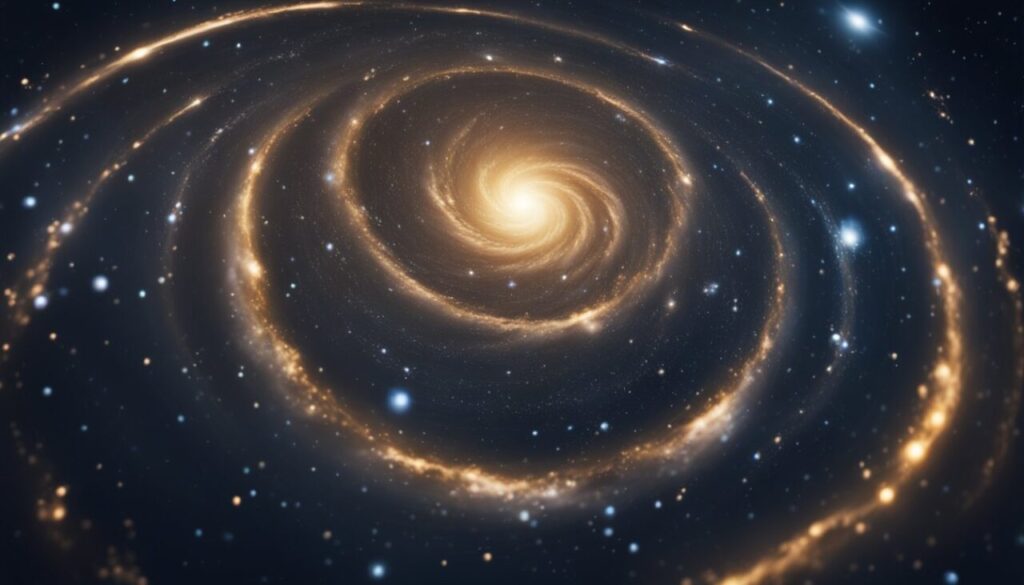
Evidence for Dark Matter
Scientists have always thought there’s more stuff in the universe than what we see with telescopes. They call this hidden stuff “dark matter.”
They figured this out by watching how galaxies move. By looking at how much normal matter a galaxy has, scientists can calculate how fast its stars should move.
But when they actually watched galaxies, the stars were zipping around way faster than expected. This means there’s gotta be extra matter in galaxies that we just can’t see.
Dark Matter and Structure Formation
Dark matter plays a crucial role in the formation of structures in the universe. Scientists believe that dark matter formed clumps in the early universe, which then attracted normal matter through gravity.
Over time, these clumps grew larger and larger, eventually forming galaxies and galaxy clusters.
Interesting fact: The largest known structure in the universe is the Hercules-Corona Borealis Great Wall, a massive collection of galaxies that spans over 10 billion light years.
Galactic Formation and Evolution
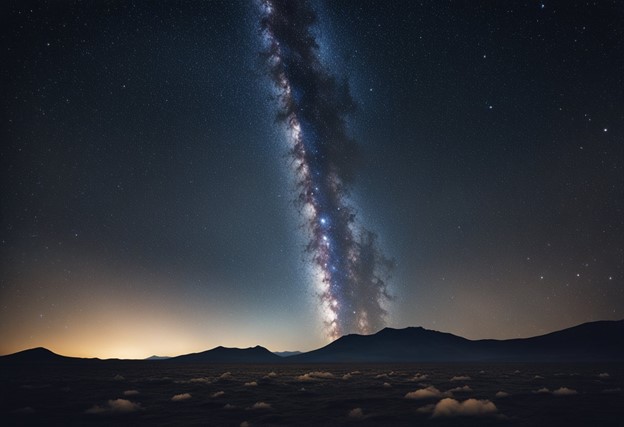
From Gas to Galaxies
Galaxies are massive collections of stars, gas, and dust that are held together by gravity. They come in a variety of shapes and sizes, ranging from spiral galaxies like our own Milky Way to irregular galaxies with no discernible shape.
But how did these galaxies form in the first place?
The current leading theory is that galaxies formed from clouds of gas and dust that collapsed under their own gravity.
Sounds, counterintuitive, ha?
Well, the explanation goes – as the cloud collapsed, it began to spin, forming a disk-like structure.
In the center of this disk, a dense core formed, which eventually became the galaxy’s central bulge.
Over time, stars began to form in the disk, and as they did, they released energy in the form of light and heat.
Interesting fact: The first galaxies are thought to have formed around 13 billion years ago, just a few hundred million years after the Big Bang.
Galactic Collisions
Galaxies are not static objects; they are constantly moving and interacting with each other. Sometimes, galaxies collide with each other, resulting in dramatic changes in their structure and appearance.
When two galaxies collide, their gas and dust clouds can merge, triggering the formation of new stars. The gravitational interaction between the galaxies can also cause their shapes to distort and stretch.
Interestingly, the Milky Way is currently on a collision course with the neighboring Andromeda galaxy.
The two galaxies are expected to collide in about 4 billion years, resulting in a new, larger galaxy dubbed “Milkomeda.”
Interesting fact: The largest known galaxy is ESO 444-46 and it is around 583 Million light years away from Earth in the constellation of Centaurus.
Stellar Nucleosynthesis
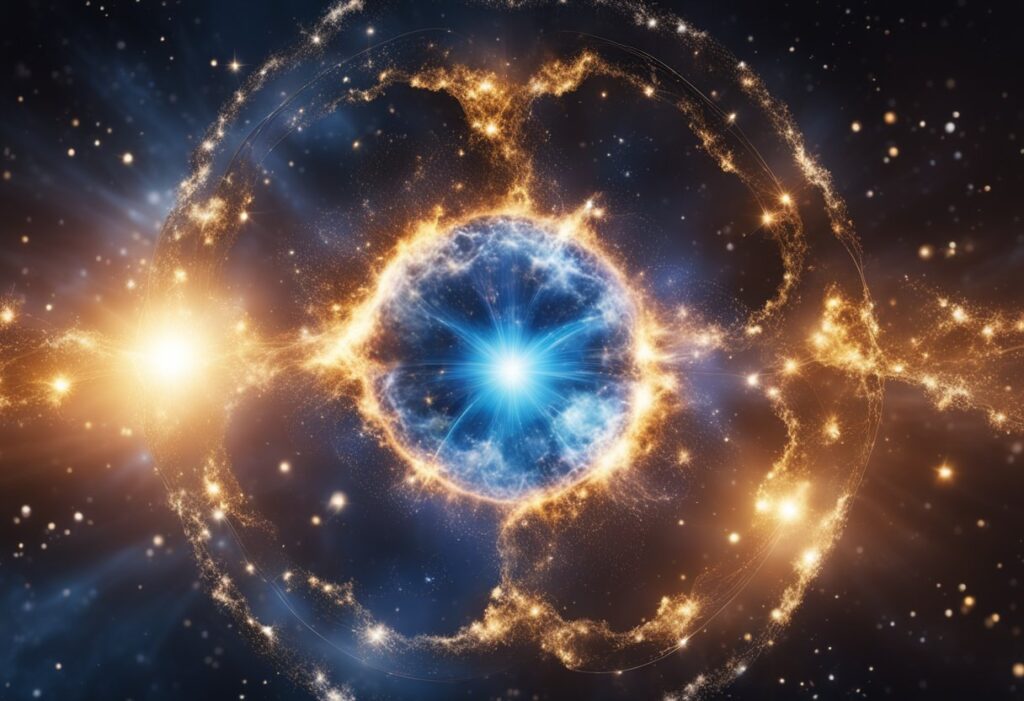
Life Cycle of Stars
Stars are born from clouds of gas and dust called nebulae. As gravity pulls these particles together, they become denser and hotter until nuclear fusion begins, creating energy and light.
As stars age, they go through different stages, depending on their mass.
Smaller stars like our sun will eventually become red giants before shedding their outer layers and becoming white dwarfs.
Larger stars, on the other hand, will end their lives in a supernova explosion, leaving behind either a neutron star or a black hole.
Interesting fact: The largest known star, UY Scuti, is so big that it would take a commercial airplane 1,100 years to fly around it once.
Creation of Heavy Elements
During the life cycle of stars, nuclear fusion reactions take place in their cores, creating helium from hydrogen and heavier elements from helium.
However, the fusion process can only create elements up to iron.
Heavier elements, such as gold and platinum, are formed in supernova explosions, where the intense pressure and heat create the necessary conditions for fusion to occur.
We’ll explain this in more detail in the next chapter because supernova contributions are rather important in element (matter) creation.
Interesting fact: The gold in our jewelry and electronics was created in a supernova explosion billions of years ago.
Overall, stellar nucleosynthesis is responsible for the creation of all elements heavier than hydrogen and helium.
Without the life cycle of stars, the universe as we know it would not exist.
Supernova Contributions
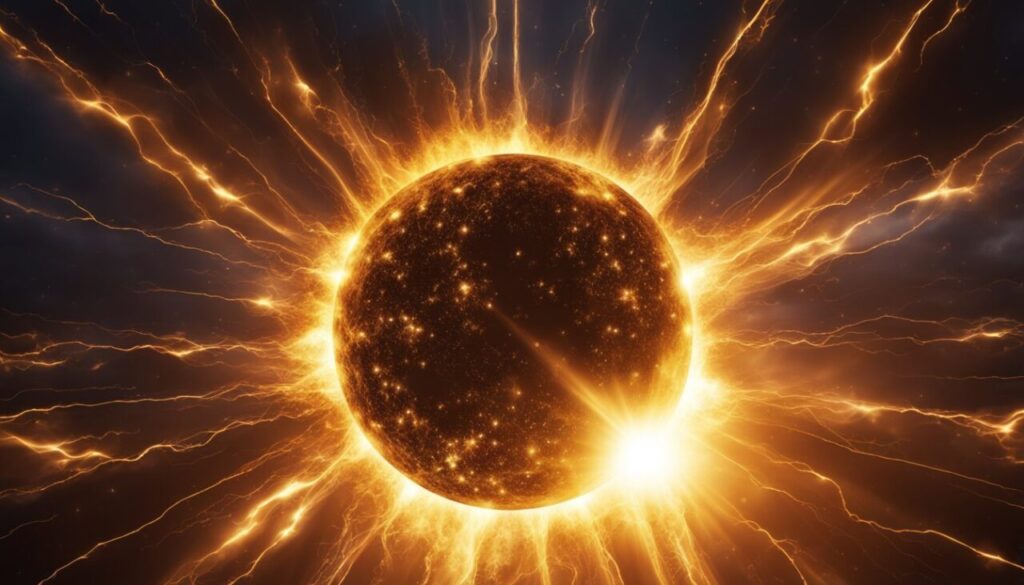
Supernova Explosions
Supernova explosions are one of the most powerful events in the universe. They occur when a star reaches the end of its life and can no longer sustain nuclear fusion reactions in its core.
The resulting explosion releases an enormous amount of energy and ejects matter into space.
These explosions are responsible for creating many of the elements we find in the universe today.
For example, here are the elements that are primarily created during supernova explosions, specifically through the rapid neutron capture process (r-process):
- Technetium (Tc)
- Ruthenium (Ru)
- Rhodium (Rh)
- Palladium (Pd)
- Silver (Ag)
- Gold (Au)
- Cadmium (Cd)
- Indium (In)
- Tin (Sn)
- Antimony (Sb)
- Tellurium (Te)
- Iodine (I)
- Xenon (Xe)
- Cesium (Cs)
- Barium (Ba)
- Lanthanum (La)
- Cerium (Ce)
- Praseodymium (Pr)
- Neodymium (Nd)
- Promethium (Pm)
- Samarium (Sm)
- Europium (Eu)
- Gadolinium (Gd)
- Terbium (Tb)
- Dysprosium (Dy)
- Holmium (Ho)
- Erbium (Er)
- Thulium (Tm)
- Ytterbium (Yb)
- Lutetium (Lu)
Interesting fact: Supernova explosions can release more energy in a few seconds than the sun will emit in its entire lifetime.
Interstellar Medium and Molecular Clouds
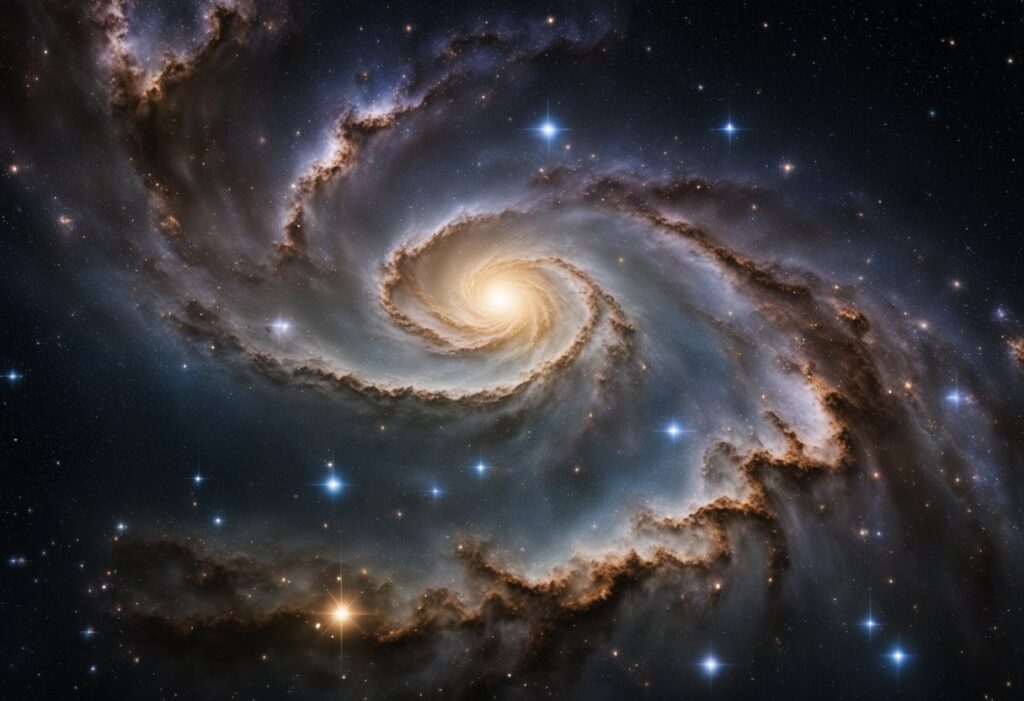
The Role of Dust and Gas
The interstellar medium (ISM) is the space between stars, which contains gas and dust. The gas in the ISM is mostly hydrogen, with some helium and trace amounts of other elements.
The dust is made up of tiny particles of carbon, silicon, and other elements. These particles absorb and scatter light, making the ISM appear dark in visible light.
Molecular clouds are dense regions of the ISM where gas and dust have come together to form molecules, such as carbon monoxide (CO) and water (H2O).
These molecules are important because they act as tracers of the densest parts of the ISM, where stars are born.
Interesting fact: Molecular clouds can have masses up to several million times that of the Sun.
Star Formation
When a molecular cloud becomes dense enough, gravity can overcome the pressure from the surrounding gas and dust, causing the cloud to collapse.
As the cloud collapses, it heats up and forms a protostar, a dense ball of gas that will eventually become a star.
As the protostar continues to collapse, it spins faster and faster, flattening into a disk of gas and dust around the star. The material in the disk can then clump together to form planets and other objects.
Planetary System Formation
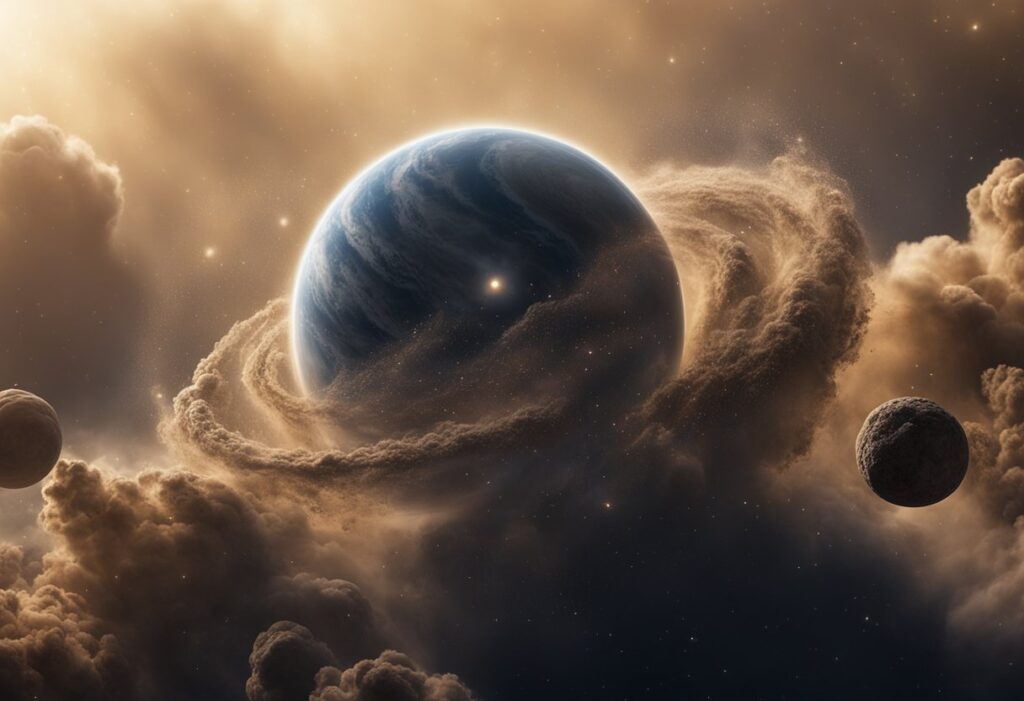
Protoplanetary Disks
When a star forms, it is surrounded by a disk of gas and dust called a protoplanetary disk. Within this disk, small particles collide and stick together, gradually growing into larger and larger bodies.
These bodies, known as planetesimals, can then continue to collide and merge to form planets.
Interesting fact: The protoplanetary disk around our own Sun was once much larger than the current Solar System, extending out to include the orbits of Uranus and Neptune.
Accretion and Planet Growth
As planetesimals collide and merge, they begin to form larger and larger bodies. Eventually, these bodies become large enough to begin attracting gas from the protoplanetary disk.
This process, known as accretion, can lead to the formation of gas giants like Jupiter and Saturn.
The Anthropic Principle
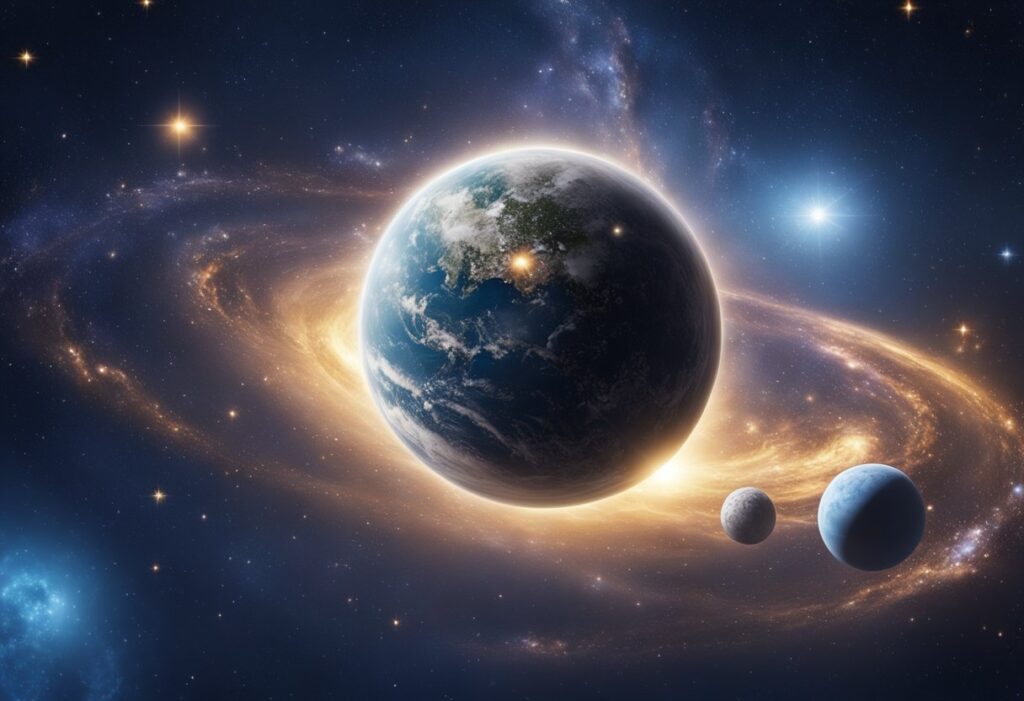
Fine-Tuning of Physical Constants
The Anthropic Principle states that the universe must be capable of supporting life because we are here to observe it. This principle has been used to explain the fine-tuning of physical constants, such as the strength of gravity and the amount of dark energy in the universe. If these constants were even slightly different, life as we know it would not exist.
Scientists have proposed various explanations for this fine-tuning, including the existence of multiple universes with different physical constants. However, there is currently no way to test these theories, and the fine-tuning of physical constants remains an open question in physics.
Interesting fact: The fine-tuning of physical constants has led some scientists to propose the existence of a multiverse, where our universe is just one of many.
Implications for the Origin of Matter
The Anthropic Principle also has implications for the origin of matter. The fact that the universe is capable of supporting life suggests that the conditions for the formation of matter were just right.
This has led some scientists to propose that the universe was designed specifically for the creation of life.
However, others argue that the Anthropic Principle is simply a consequence of the fact that we are here to observe the universe.
They point out that if the universe was not capable of supporting life, we would not be here to observe it.
Conclusion

In conclusion, the origins of all matter remain mostly a mystery to scientists, researchers, and to everyone else.
The Big Bang theory is the most widely accepted explanation for the creation of the universe and consequently all matter.
However, we really can’t confirm anything in that matter (pun intended) with 100% certainty.
Interestingly, the study of matter has led to many technological advancements and innovations.
For example, the discovery of the electron led to the development of electronics and computers.
Additionally, the study of atoms has led to the development of nuclear power and weapons.
We will continue to study the origins of matter and we will most likely find smaller and smaller particles.
And then one day perhaps we will find out that the smallest particle is actually something completely different than an atom or electron, or quark for that matter.
Physicist James Gates actually says that within the equations we use to describe the universe, you can find something surprising: computer code.
This suggests that at a fundamental level, the fabric of our universe might be connected to the same kind of binary code that runs computers.
This is a really astonishing and mind-blowing idea.
And if true, well then we could have the final answer – the origin of all matter is perhaps a computer code.
A computer code running who knows where for who knows who.



























